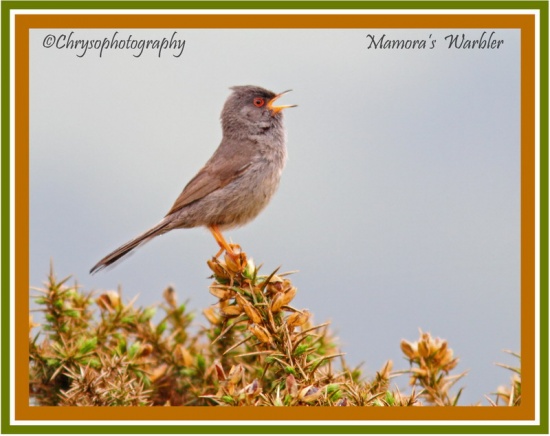Sbarnhardt (talk | contribs) (Amend Gsearch by common name, Add additional Gsearch by common name, Add Gsearch checked template) |
|||
| (17 intermediate revisions by 8 users not shown) | |||
| Line 1: | Line 1: | ||
| − | + | [[Image:Marmora's Warbler11.jpg|thumb|550px|right|Photo by {{user|Chrysophylax|Chrysophylax}}<br />Blorenge, Gwent, [[Wales]], June 2010]] | |
| − | [[Image: | + | ;[[:Category:Curruca|Curruca]] sarda |
| + | ''Sylvia sarda'' | ||
==Identification== | ==Identification== | ||
| − | + | 12·5 cm (5 in) | |
| − | + | *Long tailed | |
| − | + | *Grey upperparts | |
| − | + | *Light grey underparts | |
| − | + | *Greyish-black forehead and [[Topography#Heads|lores]] | |
| − | + | *Pointed bill | |
| + | *Red legs and iris | ||
==Distribution== | ==Distribution== | ||
| − | + | [[Corsica]], [[Sardinia]], Montecristo, Pantelleria, Giannutri and Zembra. | |
| + | ==Taxonomy== | ||
| + | This is a [[Dictionary_M-O#M|monotypic]] species.<br /> | ||
| + | It was formerly considered conspecific with [[Balearic Warbler]]. | ||
| − | |||
| − | |||
==Habitat== | ==Habitat== | ||
| − | + | Open country with thorny bushes and heather. | |
==Behaviour== | ==Behaviour== | ||
| − | + | ====Breeding==== | |
| − | + | They nest in a bush, laying 3-5 eggs. | |
| − | + | ====Diet==== | |
| − | + | Diet includes insects. | |
| − | + | ==References== | |
| − | + | #{{Ref-Clements6thAug21}}#Avibase | |
| + | #Collins Bird Guide ISBN 0 00 219728 | ||
| + | #Wikipedia | ||
| + | {{ref}} | ||
==External Links== | ==External Links== | ||
| − | + | Search by scientific name ''Curruca sarda'': | |
| − | [[Category:Birds]] | + | {{GSearch|Curruca+sarda}} |
| + | Edit by common name: | ||
| + | {{GSearch|"Marmora's Warbler"}} | ||
| + | {{GS-checked}} | ||
| + | [[Category:Birds]] [[Category:Curruca]] | ||
Latest revision as of 15:16, 6 October 2022
- Curruca sarda
Sylvia sarda
Identification
12·5 cm (5 in)
- Long tailed
- Grey upperparts
- Light grey underparts
- Greyish-black forehead and lores
- Pointed bill
- Red legs and iris
Distribution
Corsica, Sardinia, Montecristo, Pantelleria, Giannutri and Zembra.
Taxonomy
This is a monotypic species.
It was formerly considered conspecific with Balearic Warbler.
Habitat
Open country with thorny bushes and heather.
Behaviour
Breeding
They nest in a bush, laying 3-5 eggs.
Diet
Diet includes insects.
References
- Clements, J. F., T. S. Schulenberg, M. J. Iliff, S. M. Billerman, T. A. Fredericks, J. A. Gerbracht, D. Lepage, B. L. Sullivan, and C. L. Wood. 2021. The eBird/Clements checklist of Birds of the World: v2021. Downloaded from https://www.birds.cornell.edu/clementschecklist/download/
- Avibase
- Collins Bird Guide ISBN 0 00 219728
- Wikipedia
Recommended Citation
- BirdForum Opus contributors. (2024) Marmora's Warbler. In: BirdForum, the forum for wild birds and birding. Retrieved 14 May 2024 from https://www.birdforum.net/opus/Marmora%27s_Warbler
External Links
Search by scientific name Curruca sarda:
Edit by common name:
GSearch checked for 2020 platform.




